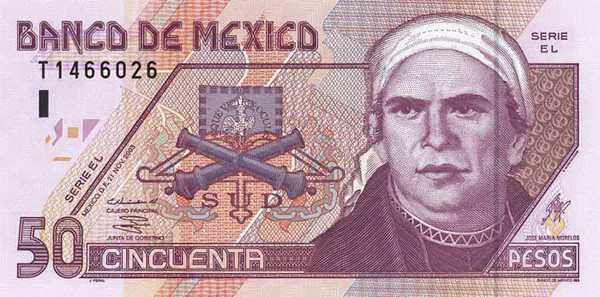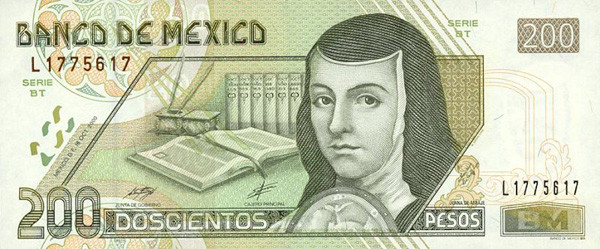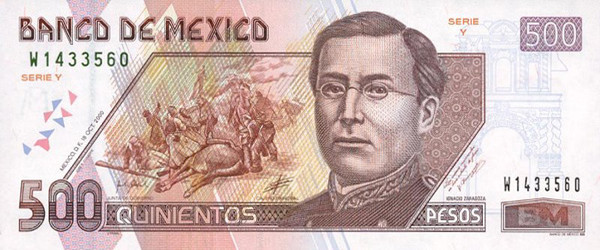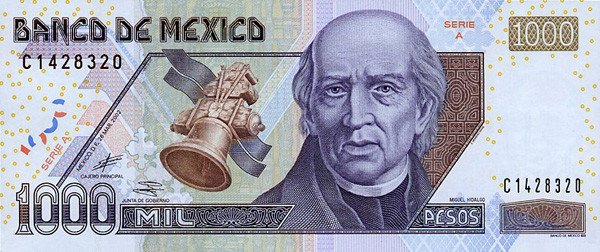Mexican Bills come in six denominations: 20, 50, 100, 200, 500 and the newly unveiled 1000 peso note.
 The 20 peso note (re-issued in 2001 in a plastic form) shows dapper Benito Juarez. Born in March 1806 in a village in the state of Oaxaca from a poor, illiterate peasant family. Juarez didn’t know how to read or write until he was 12 years old, when he also learned Spanish. He studied Latin, theology, philosophy, arts and sciences, then took up law and entered politics. He held several posts in state and national administration and was twice jailed and once deported for his political beliefs. When the rebellion for Mexican Independence began, he became a Minister of Justice and later President of the Republic and was a strong advocate for the poor. He was re-elected President of Mexico in 1867 and held the post for seven years. He died in July 1872.
The 20 peso note (re-issued in 2001 in a plastic form) shows dapper Benito Juarez. Born in March 1806 in a village in the state of Oaxaca from a poor, illiterate peasant family. Juarez didn’t know how to read or write until he was 12 years old, when he also learned Spanish. He studied Latin, theology, philosophy, arts and sciences, then took up law and entered politics. He held several posts in state and national administration and was twice jailed and once deported for his political beliefs. When the rebellion for Mexican Independence began, he became a Minister of Justice and later President of the Republic and was a strong advocate for the poor. He was re-elected President of Mexico in 1867 and held the post for seven years. He died in July 1872.
 The gentleman with a bandanna covering his head on the 50 peso bill is Jose Maria Morelos y Pavón who was born in September 1765 in Valladolid, renamed Morelia in his honor after his death. His father was a carpenter and his mother, a school teacher. At age 30, he entered the priesthood, studying under the celebrated Miguel Hidalgo, whose sermons urged independence, freedom and liberty. Morelos offered his services, not asking for weapons nor money and became a victorious rebel leader with many impressive victories. The radical priest/rebel was captured and executed by firing squad on December 22, 1815.
The gentleman with a bandanna covering his head on the 50 peso bill is Jose Maria Morelos y Pavón who was born in September 1765 in Valladolid, renamed Morelia in his honor after his death. His father was a carpenter and his mother, a school teacher. At age 30, he entered the priesthood, studying under the celebrated Miguel Hidalgo, whose sermons urged independence, freedom and liberty. Morelos offered his services, not asking for weapons nor money and became a victorious rebel leader with many impressive victories. The radical priest/rebel was captured and executed by firing squad on December 22, 1815.
 On the 100 peso bill is Netzahualcóyotl, whose name means “starving coyote”. The son of King Chichimeca-Texcocano, the mustached poet king grew up to be a warrior of great courage and valor with a strong interest in science. He assumed the position of governor of Texcoco, capital of the Acolhua and Chichimeca kingdom, in 1431 and held the post for 41 years. He was known as a powerful, civilized man, very intelligent and wise. He built elevated hanging gardens similar to the famed ones in Babylon, as well as palaces, monuments, aqueducts, public baths and a great number of edifices which made the capital a large beautiful city; he studied and cultivated the arts, sciences and literature; passed beneficial laws; wrote poetry and philosophy. Netzahualcóyotl died in 1472.
On the 100 peso bill is Netzahualcóyotl, whose name means “starving coyote”. The son of King Chichimeca-Texcocano, the mustached poet king grew up to be a warrior of great courage and valor with a strong interest in science. He assumed the position of governor of Texcoco, capital of the Acolhua and Chichimeca kingdom, in 1431 and held the post for 41 years. He was known as a powerful, civilized man, very intelligent and wise. He built elevated hanging gardens similar to the famed ones in Babylon, as well as palaces, monuments, aqueducts, public baths and a great number of edifices which made the capital a large beautiful city; he studied and cultivated the arts, sciences and literature; passed beneficial laws; wrote poetry and philosophy. Netzahualcóyotl died in 1472.
 The 200 peso note depicts Sor Juana Inés de la Cruz (aka Juana de Asbaje), born in November 1651 to a Basque father and a Creole mother. At age 7 or 8 she asked to be sent to a university and at age 8 wrote religious poems. Extremely pious, she entered the convent, San Jose de las Carmelitas Descalzas in 1667 and was placed in charge of the convent’s archives. She acquired some 4,000 books and a considerable knowledge of languages, philosophy, theology, astronomy and art, and became a well known writer of religious sonnets, musical scores, philosophical theses, biographies, plays and comedies. In the 1690’s she sold her library, giving the money to the children and the poor. She died in April 1695 as various deadly floods and epidemics swept through New Spain. After her death, her father confessor nominated her for sainthood.
The 200 peso note depicts Sor Juana Inés de la Cruz (aka Juana de Asbaje), born in November 1651 to a Basque father and a Creole mother. At age 7 or 8 she asked to be sent to a university and at age 8 wrote religious poems. Extremely pious, she entered the convent, San Jose de las Carmelitas Descalzas in 1667 and was placed in charge of the convent’s archives. She acquired some 4,000 books and a considerable knowledge of languages, philosophy, theology, astronomy and art, and became a well known writer of religious sonnets, musical scores, philosophical theses, biographies, plays and comedies. In the 1690’s she sold her library, giving the money to the children and the poor. She died in April 1695 as various deadly floods and epidemics swept through New Spain. After her death, her father confessor nominated her for sainthood.
 The 500 peso note represents Ignacio Zaragoza, known as the “Defender of the Nation.” Born in March 1829, the son of an Army captain, he became a soldier himself and went on to lead many winning battles in the fight for independence and against foreign invaders. With two other generals he formed the Liberal Party. With the triumph of the Liberal Party he became Minister of War and fought against the French invasion. Against superior foreign forces, he defeated the French at the decisive battle of Puebla on May 5, 1862, (giving rise to the Mexican Holiday “Cinco de Mayo”). Zaragoza retired soon after the battle and died of typhus in September 1862.
The 500 peso note represents Ignacio Zaragoza, known as the “Defender of the Nation.” Born in March 1829, the son of an Army captain, he became a soldier himself and went on to lead many winning battles in the fight for independence and against foreign invaders. With two other generals he formed the Liberal Party. With the triumph of the Liberal Party he became Minister of War and fought against the French invasion. Against superior foreign forces, he defeated the French at the decisive battle of Puebla on May 5, 1862, (giving rise to the Mexican Holiday “Cinco de Mayo”). Zaragoza retired soon after the battle and died of typhus in September 1862.
 The new (2004) 1000 peso note shows the bust of Miguel Hidalgo y Costilla (1753-1831), “Father of the Nation,” who initiated and launched the call for Mexican Independence, his now famous “El Grito” on the night of September 15, 1810 from the church of Dolores in the State of Guanajuato. The 57-year-old Catholic priest soon attracted hundreds of disenchanted Mexicans. On December 6, 1810, Hidalgo left Dolores with only 600 insurgents but in a few days that number grew to 100,000. Their first victory was in the taking of the fortified city of Guanajuato. They then marched on to Mexico City and defeated the Spanish at the battle of Monte de la Crucas. However, Hidalgo failed to occupy the town and retreated north. He suffered his first defeat in San Jeronimo Aculco and retired to Guadalajara, gathering more converts. He was finally defeated in Chihuahua where he was captured and executed by firing squad on July 30, 1831. His head was publicly displayed in Guanajuato for the following 10 years.
The new (2004) 1000 peso note shows the bust of Miguel Hidalgo y Costilla (1753-1831), “Father of the Nation,” who initiated and launched the call for Mexican Independence, his now famous “El Grito” on the night of September 15, 1810 from the church of Dolores in the State of Guanajuato. The 57-year-old Catholic priest soon attracted hundreds of disenchanted Mexicans. On December 6, 1810, Hidalgo left Dolores with only 600 insurgents but in a few days that number grew to 100,000. Their first victory was in the taking of the fortified city of Guanajuato. They then marched on to Mexico City and defeated the Spanish at the battle of Monte de la Crucas. However, Hidalgo failed to occupy the town and retreated north. He suffered his first defeat in San Jeronimo Aculco and retired to Guadalajara, gathering more converts. He was finally defeated in Chihuahua where he was captured and executed by firing squad on July 30, 1831. His head was publicly displayed in Guanajuato for the following 10 years.
**A note if you find yourself in possession of the 1,000 peso note, it can be a hindrance to change into smaller denominations, and might require a trip to the bank to use it.
-January 2005
Editor´s Note: Mexico commemorated the centenary of the Revolution and the bicentennial of the Independence of Mexico in 2010 by inaugurating new 100 and 200 pesos banknotes, see ADIP December 2009 for more information.



